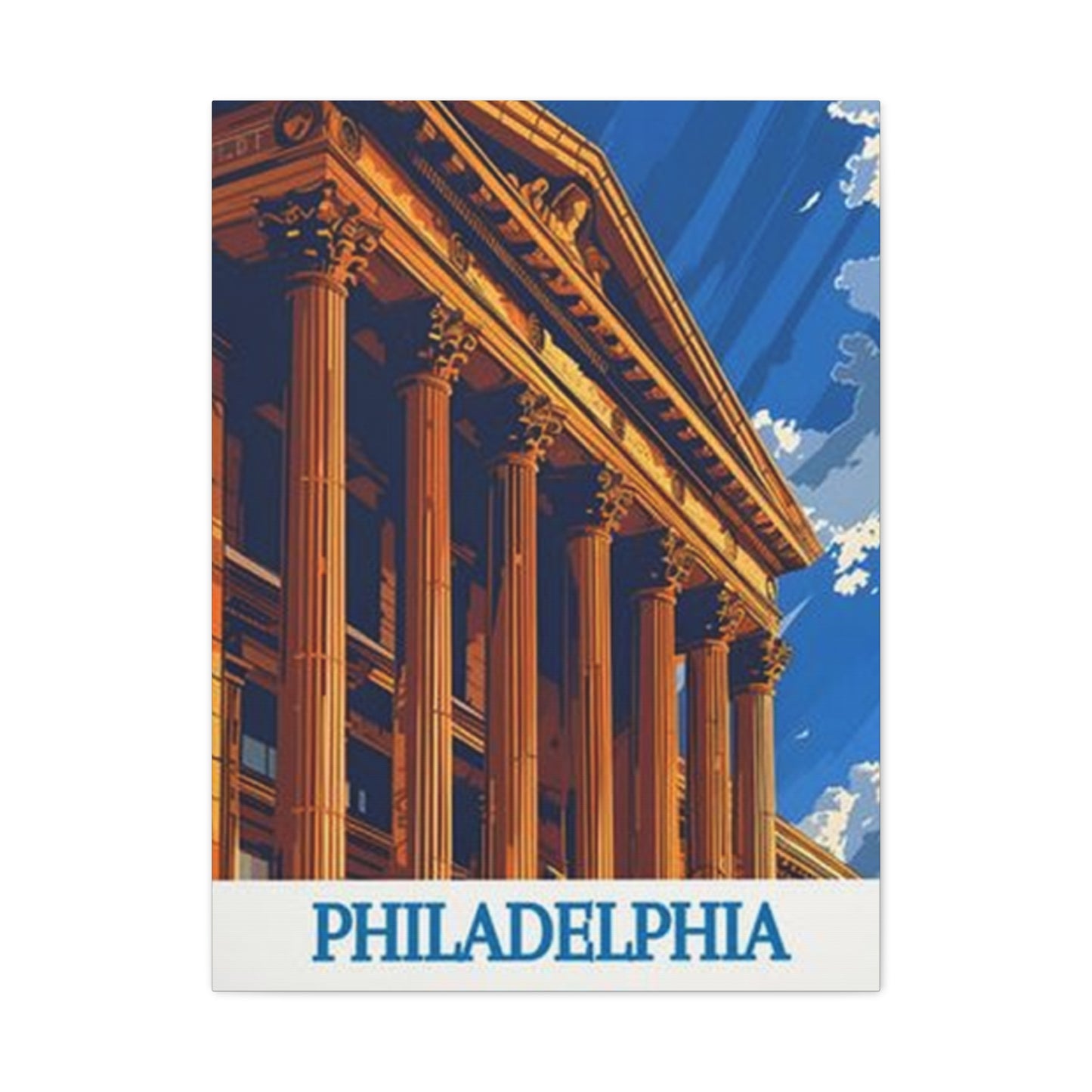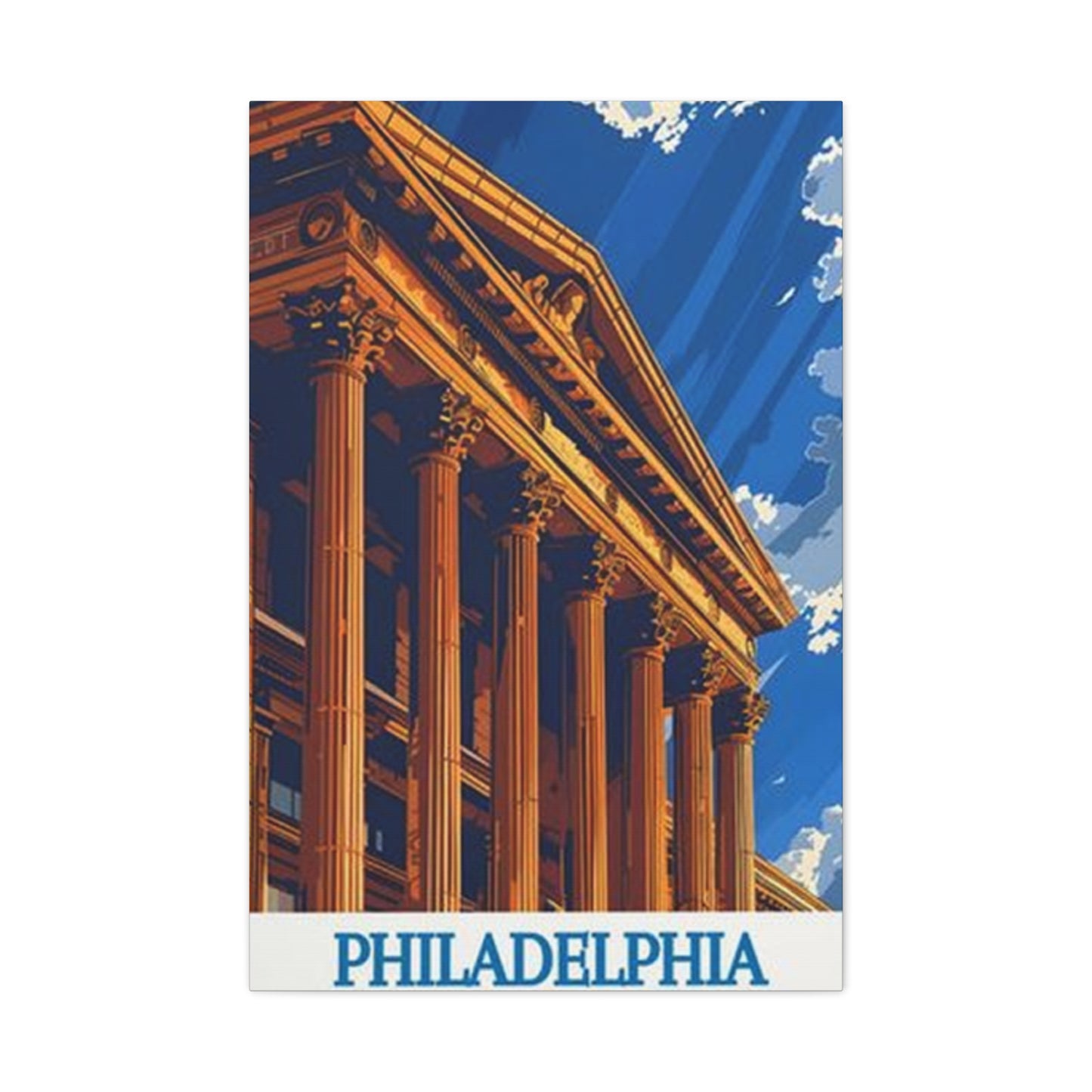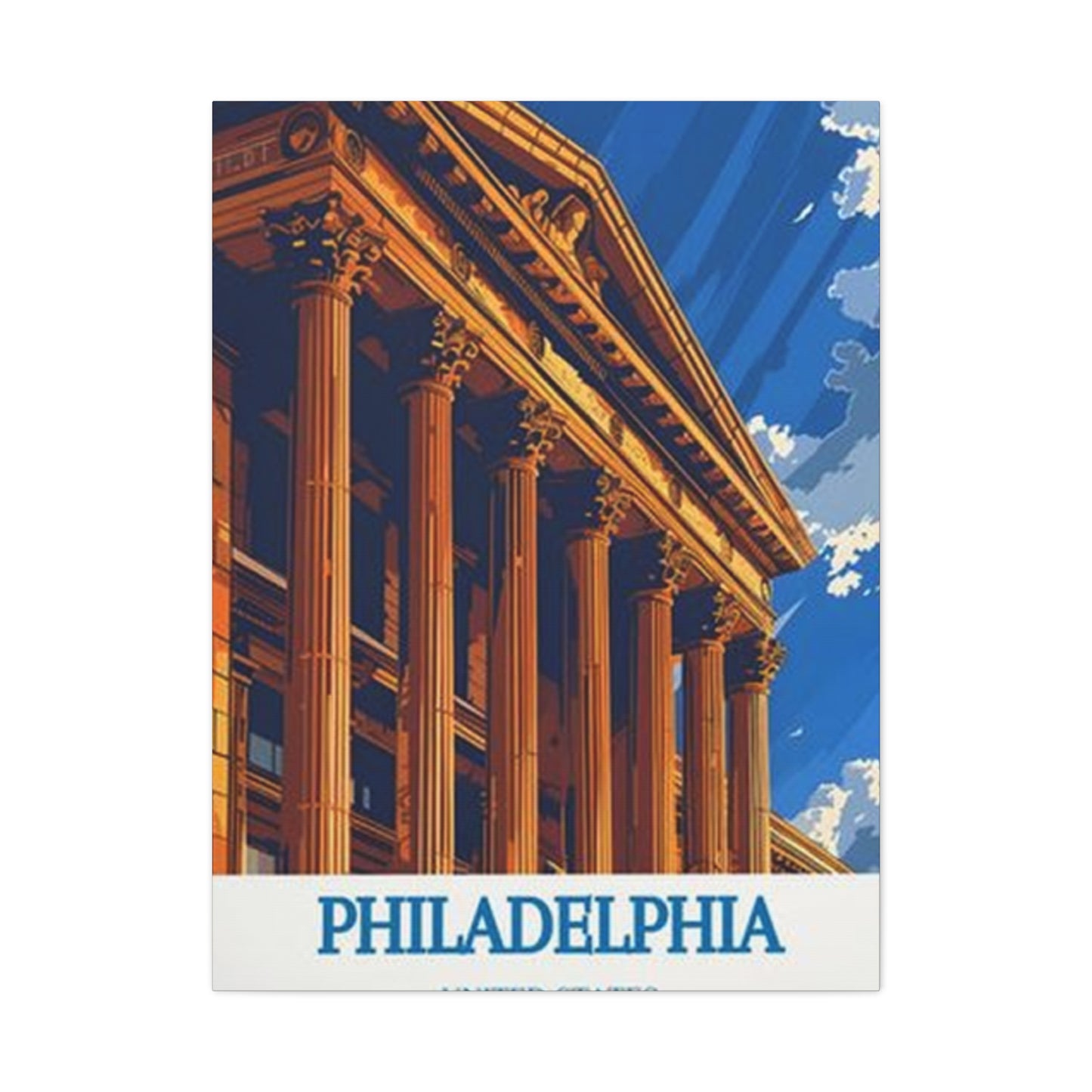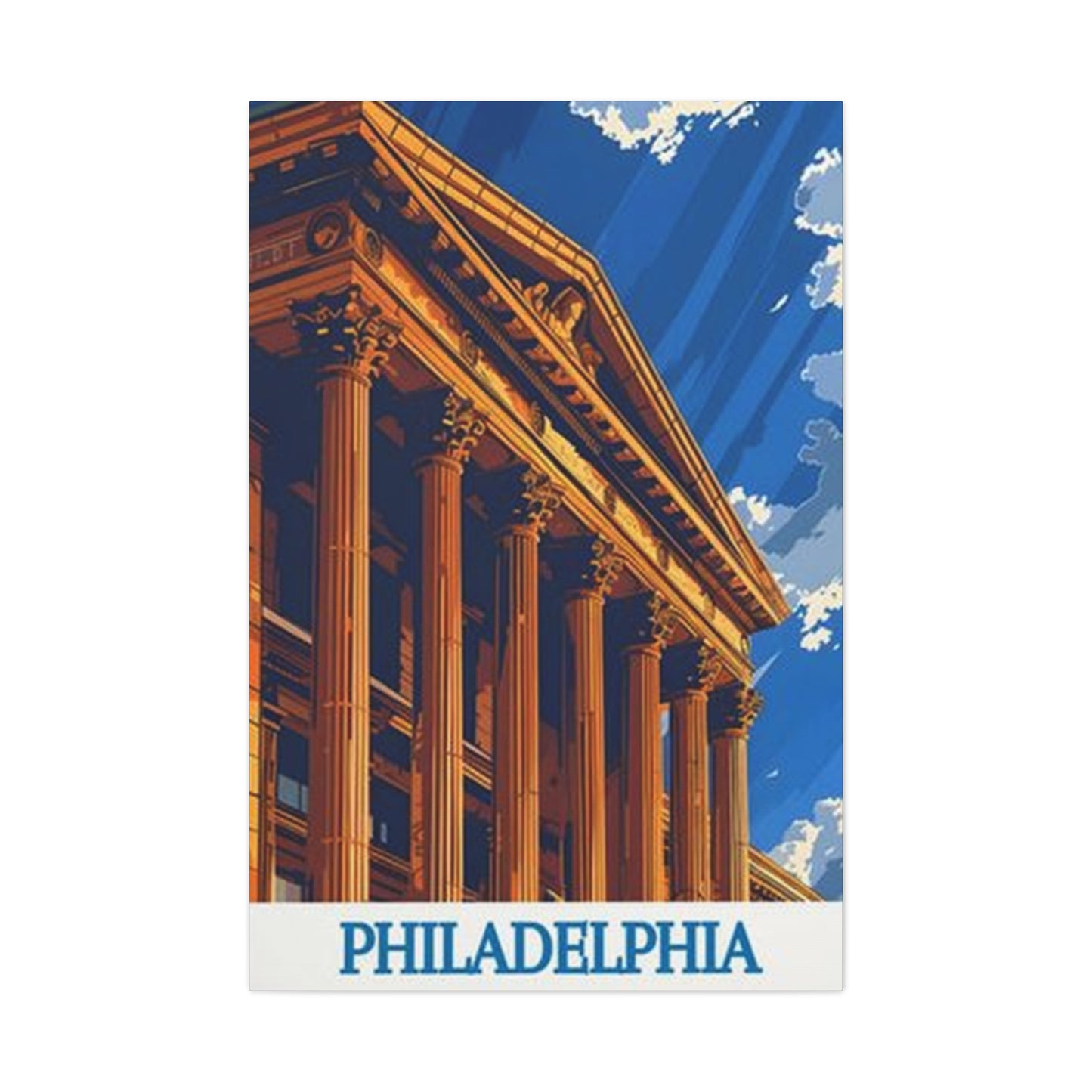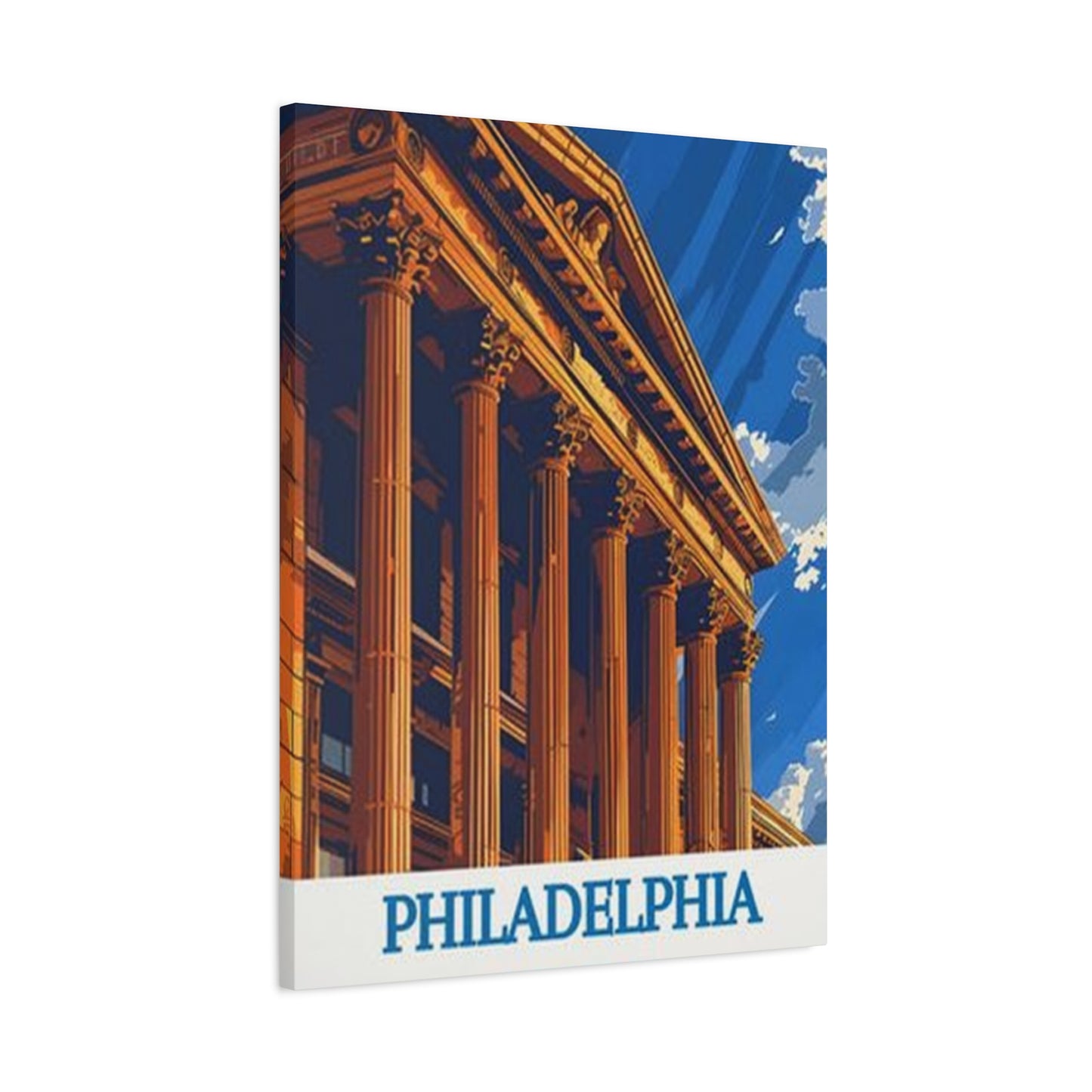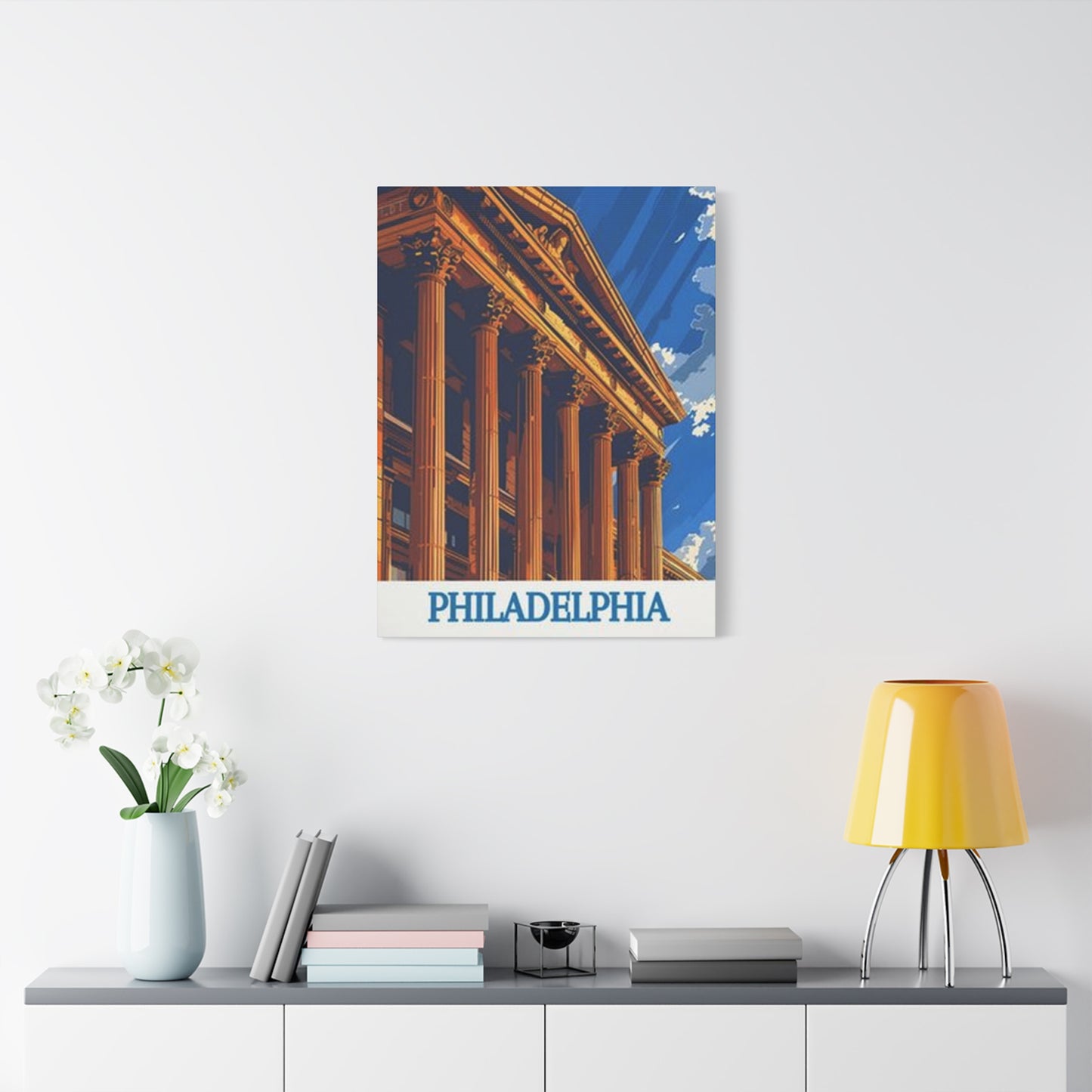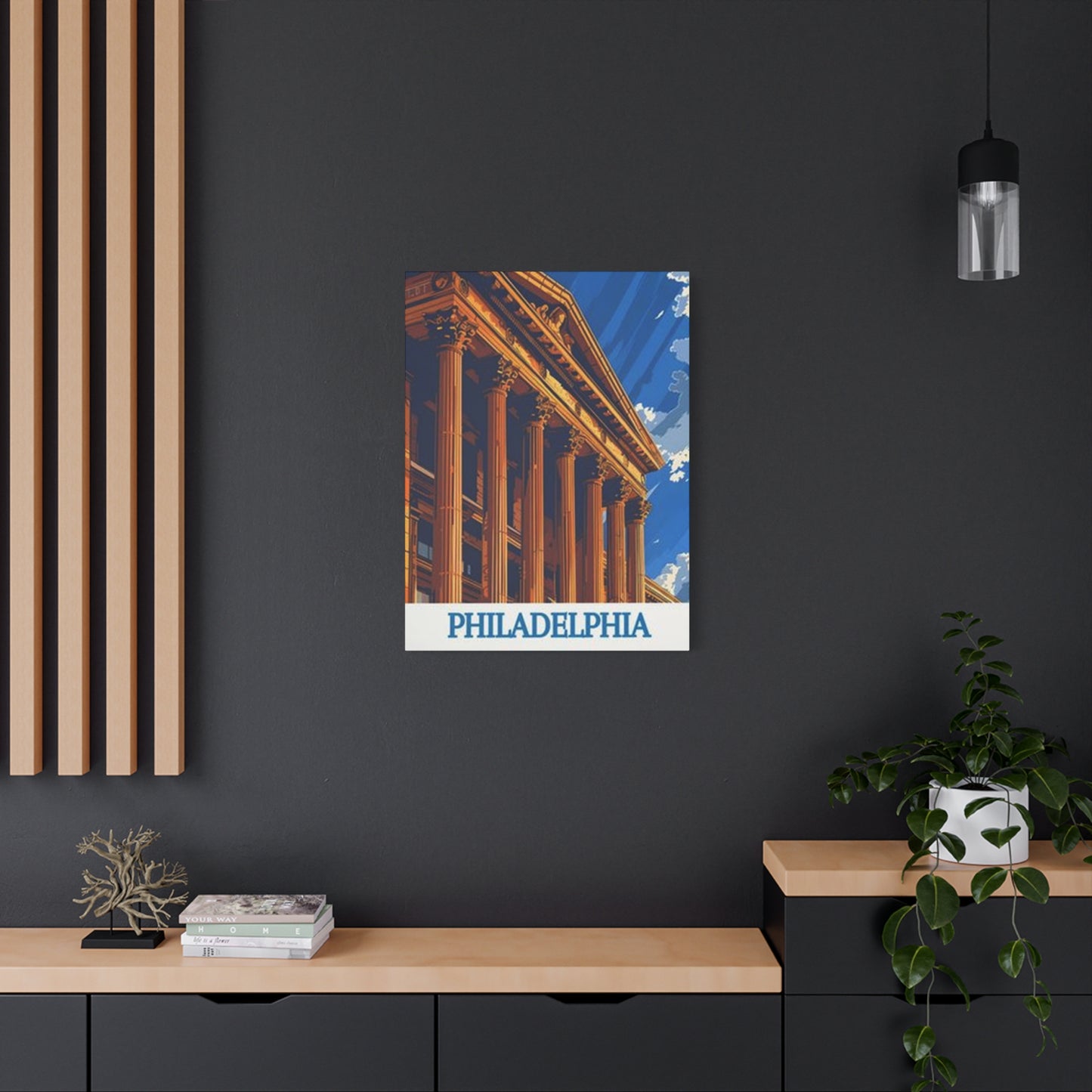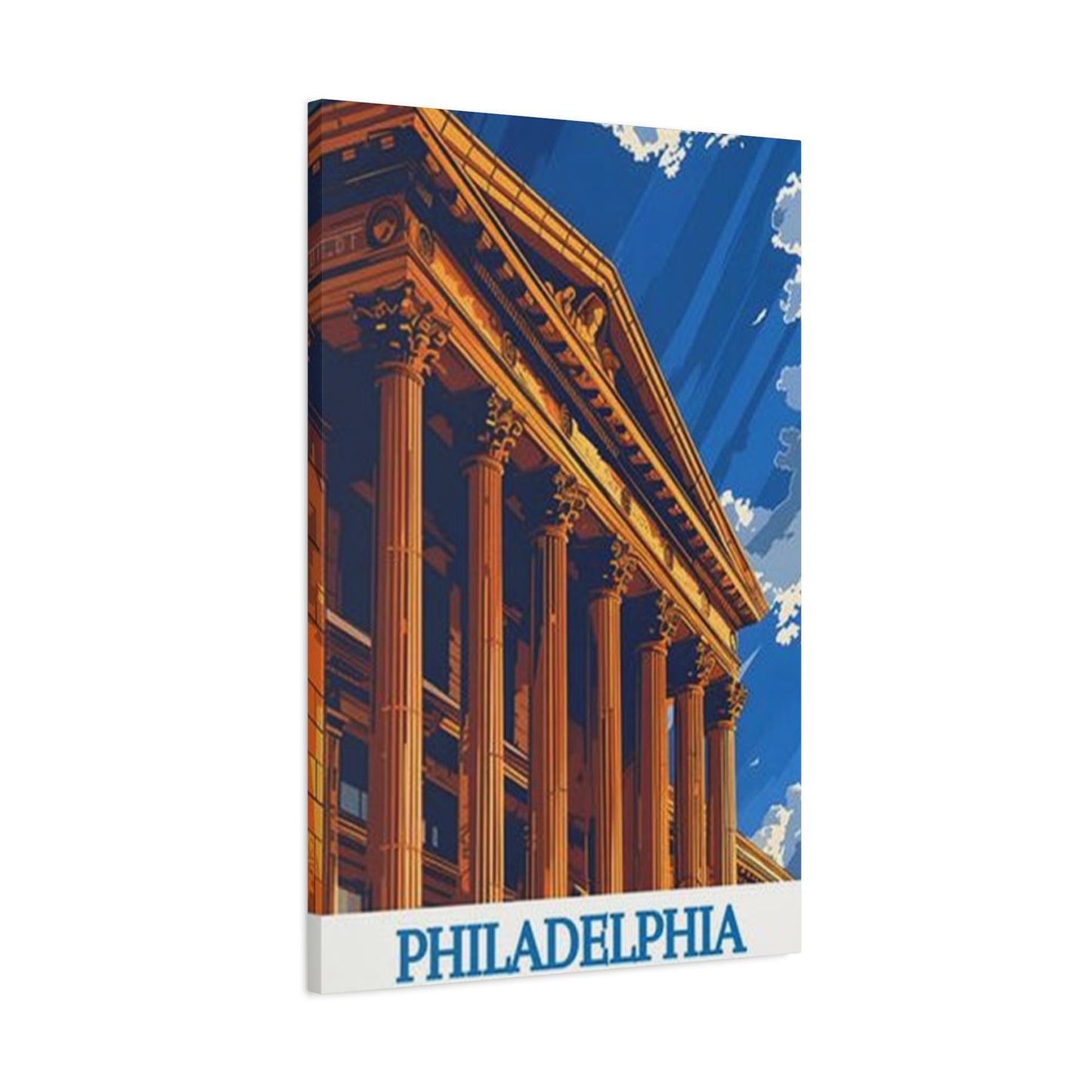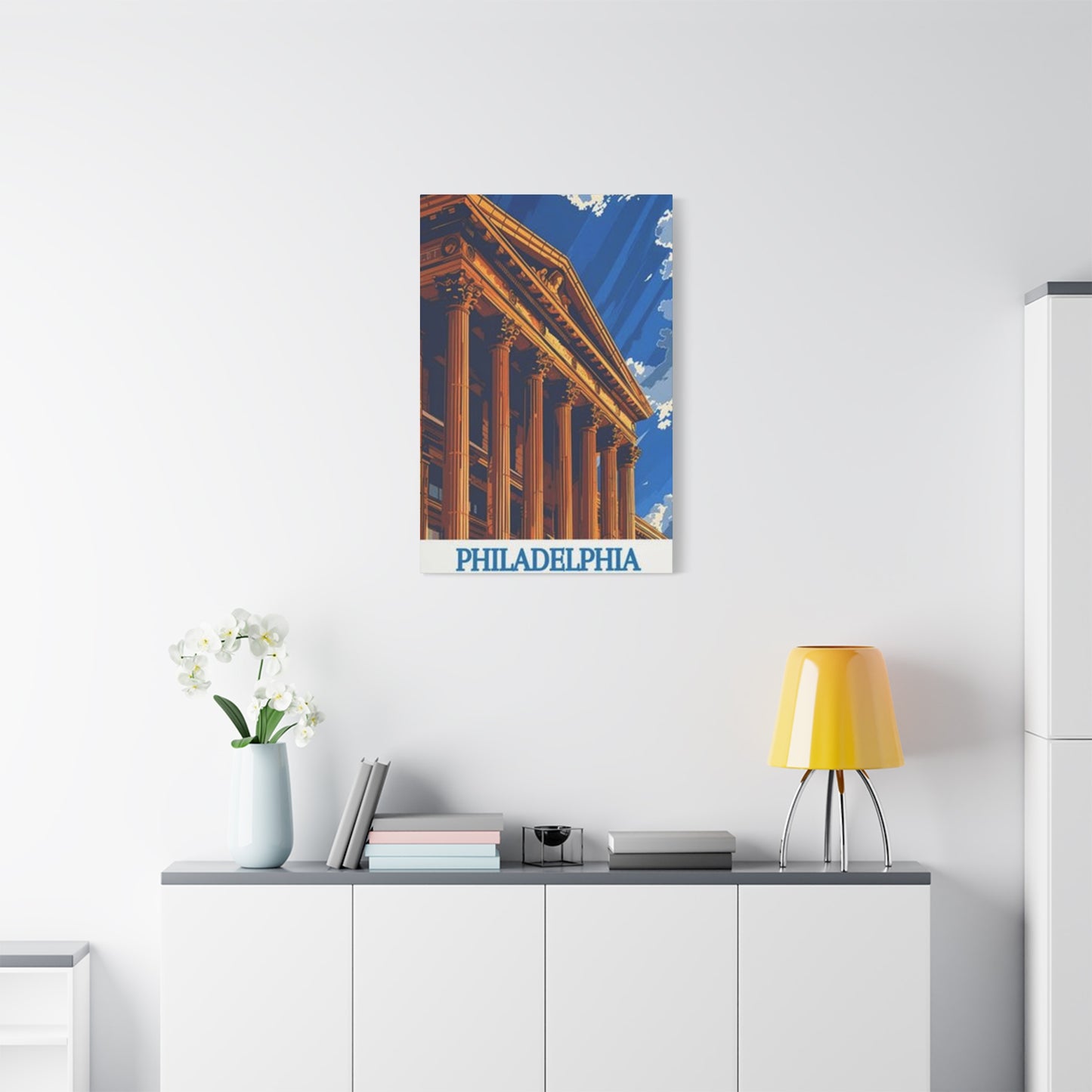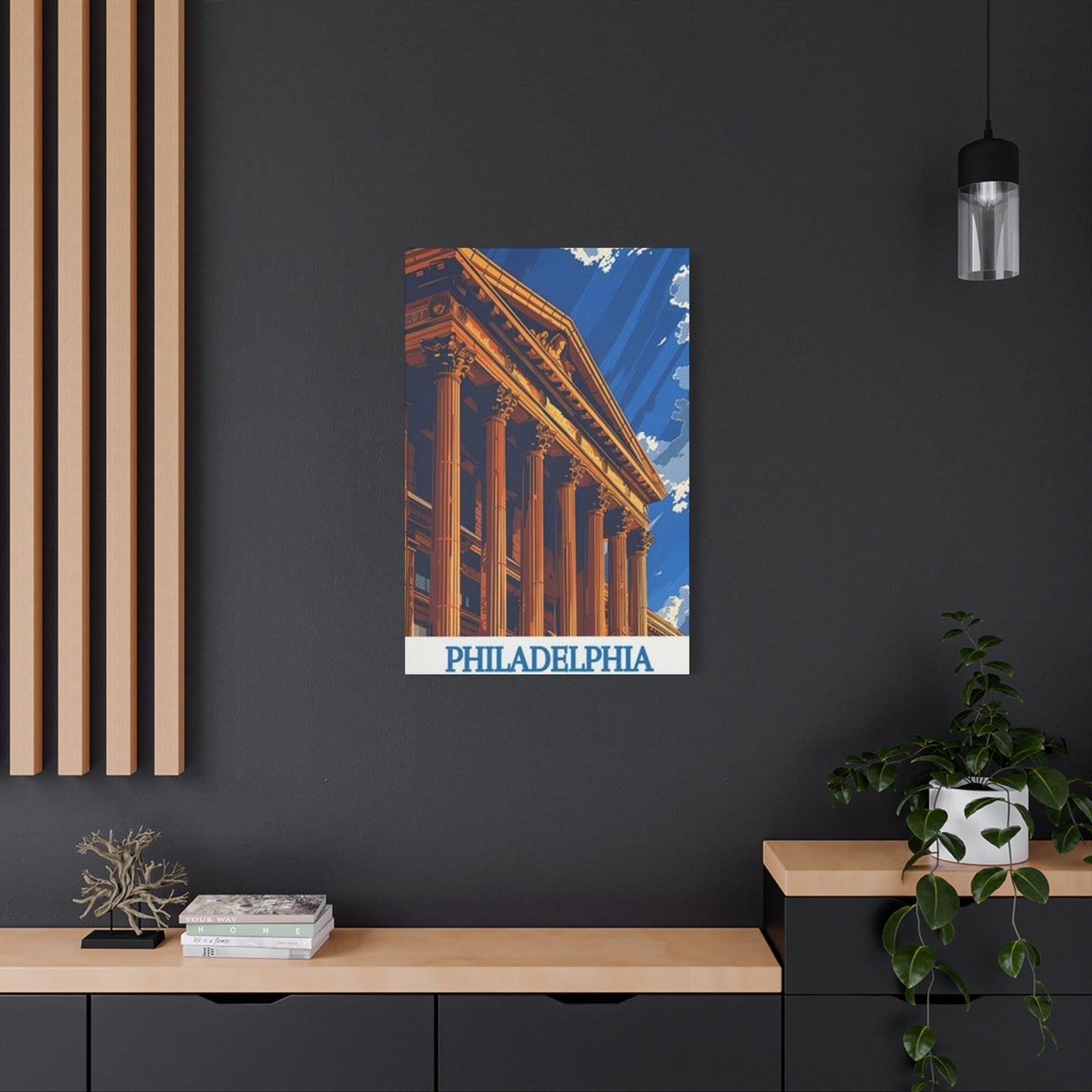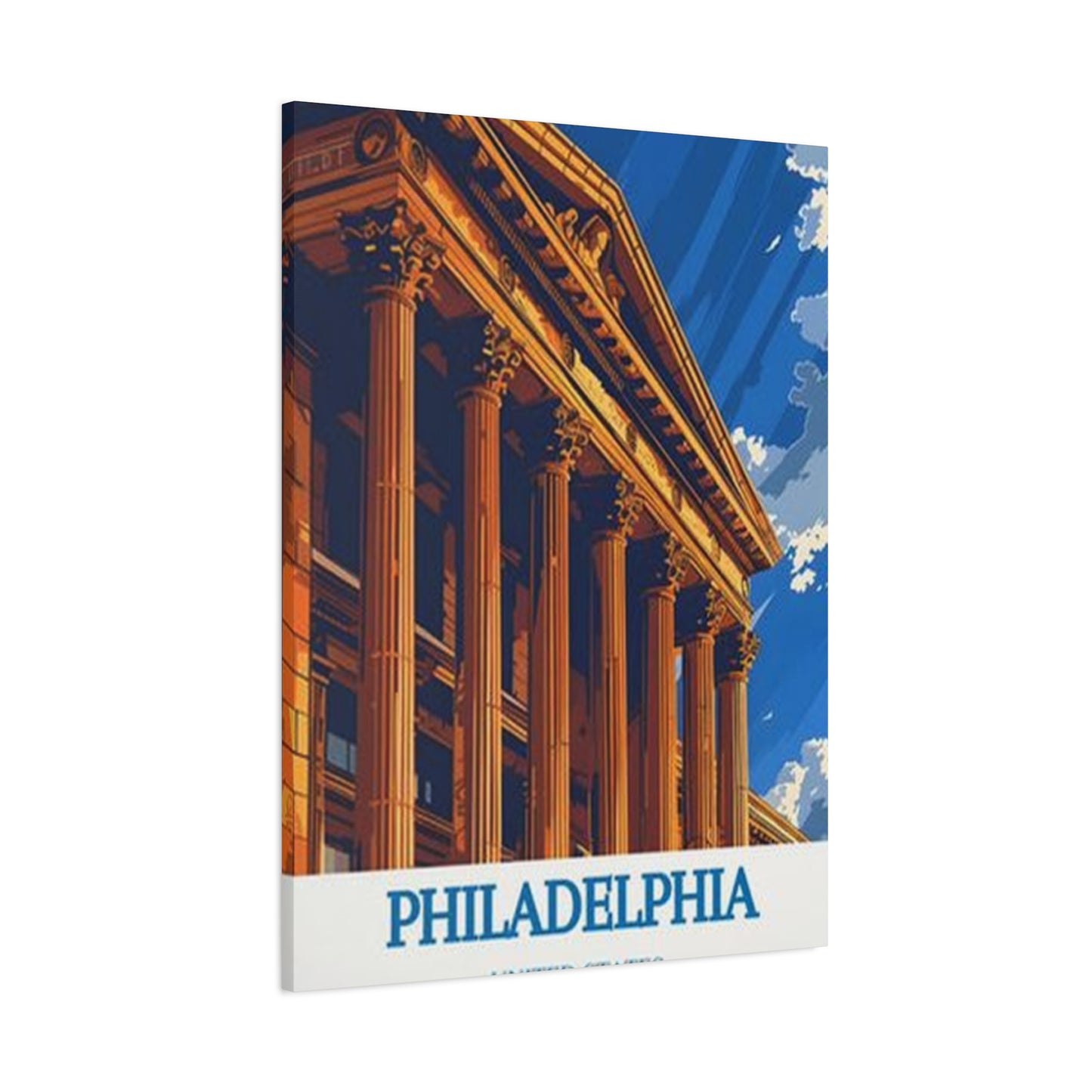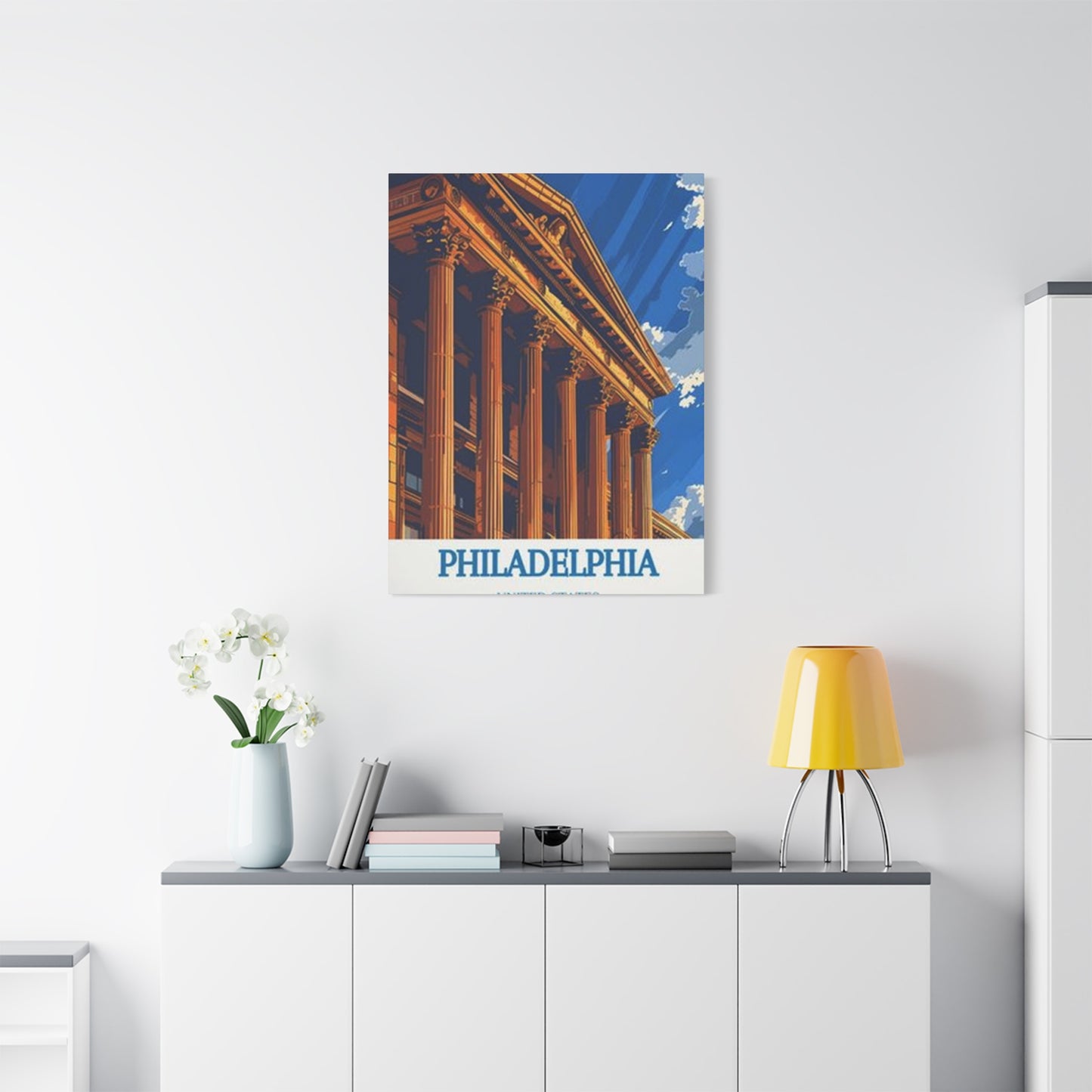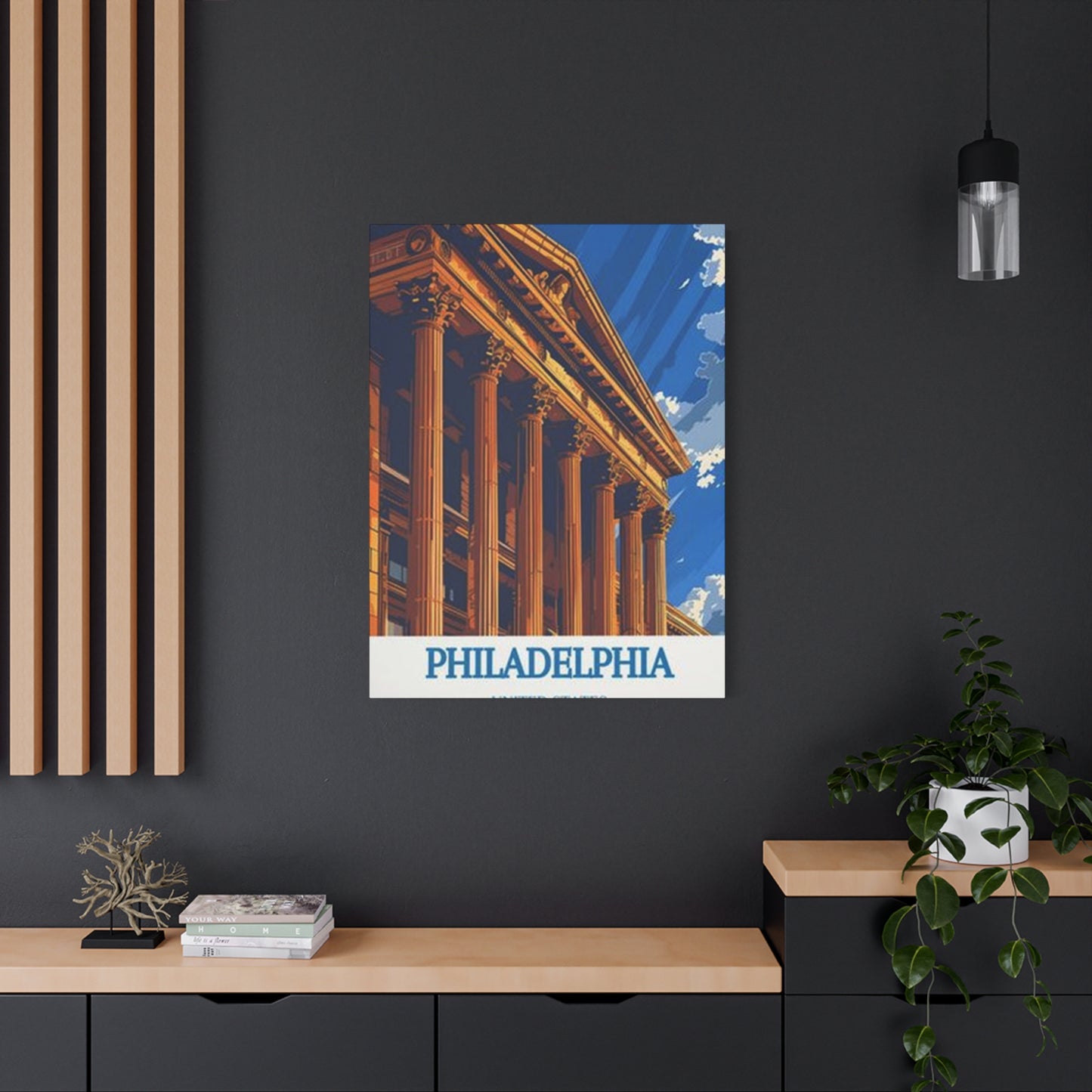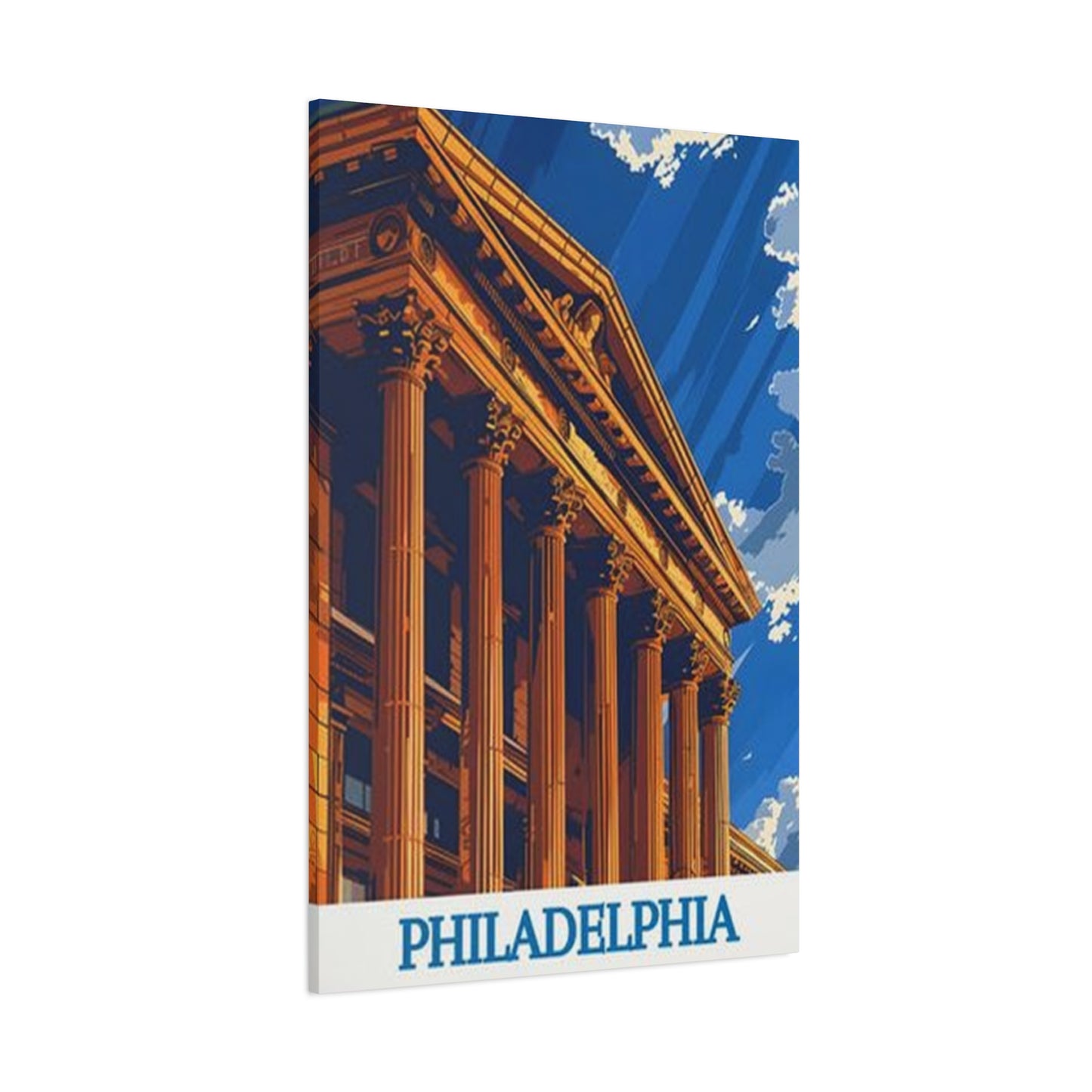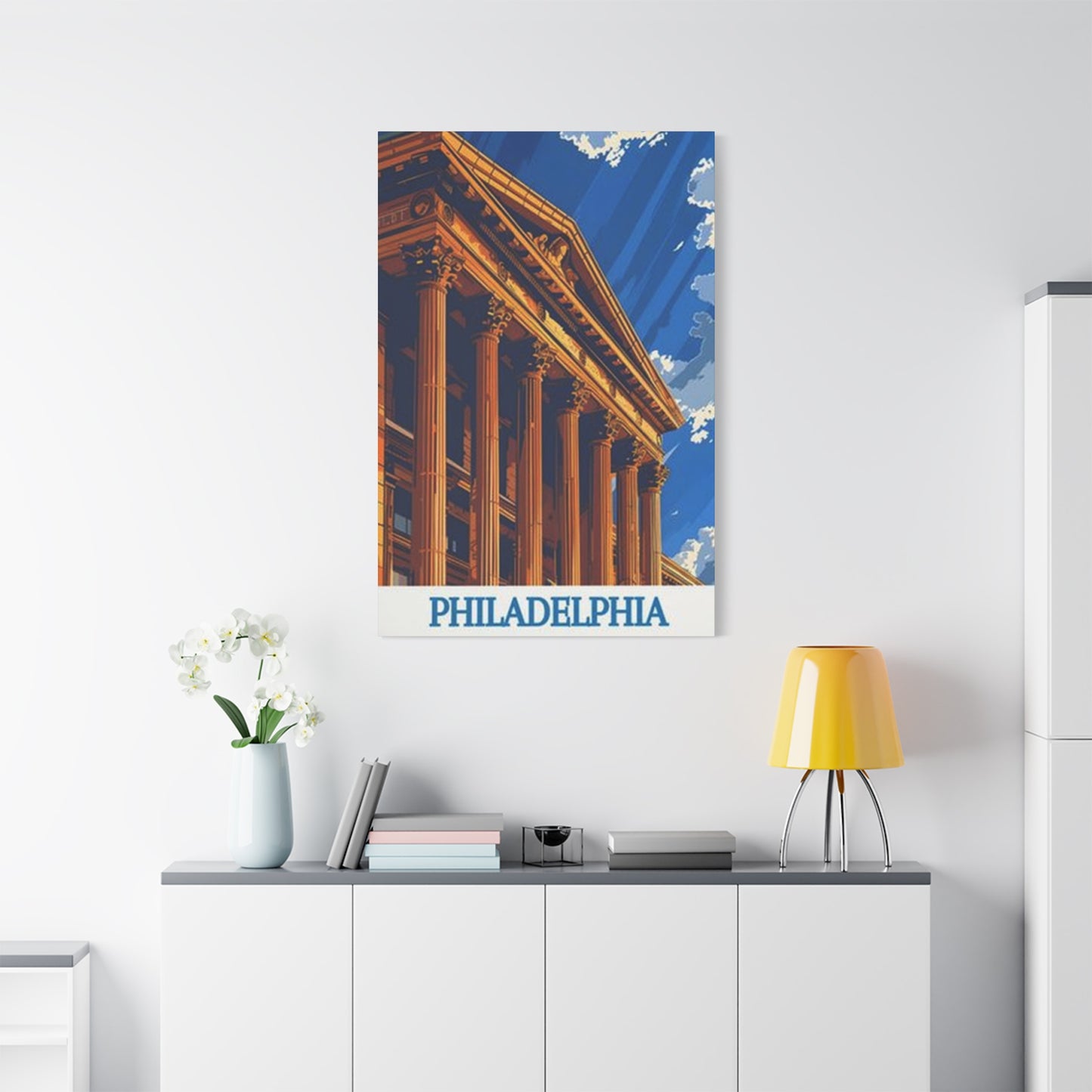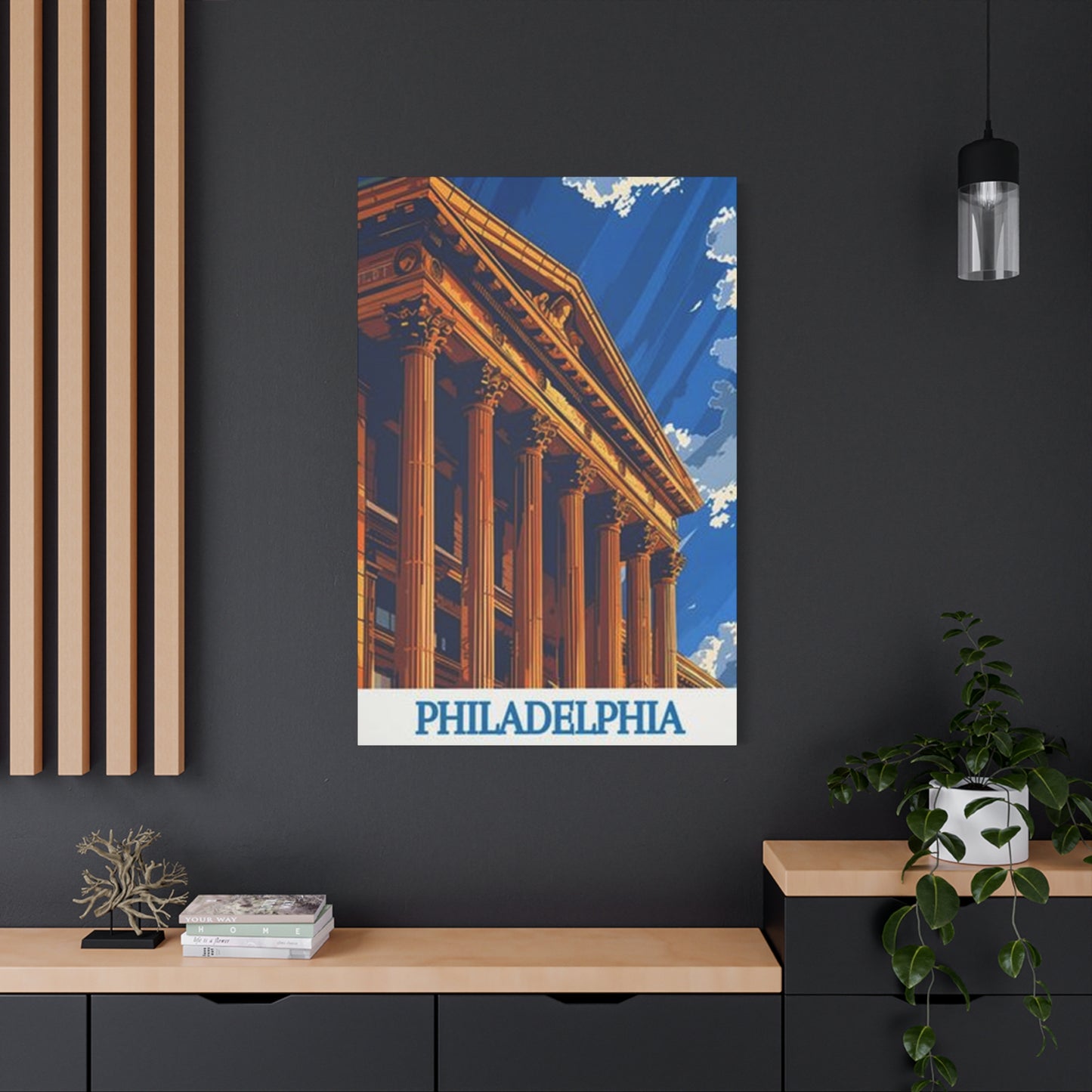Philadelphia Architecture Canvas Art: Iconic City Structures for Your Walls
Philadelphia stands as one of America's most architecturally diverse cities, where colonial brick buildings share sidewalks with gleaming modern towers, and where every street corner tells a story through stone, steel, and glass. The rich architectural heritage of this historic metropolis has captured the imagination of artists, photographers, and designers who seek to bring these magnificent structures into interior spaces through carefully crafted canvas prints. These artistic interpretations of Philadelphia's built environment offer homeowners, office managers, and design enthusiasts an opportunity to celebrate the city's unique character while creating visually compelling wall displays that speak to both history and contemporary aesthetics.
The appeal of Philadelphia architecture canvas prints extends far beyond simple decoration. These pieces serve as cultural artifacts that preserve and celebrate the visual legacy of a city that played a pivotal role in American history. From the iconic Independence Hall with its distinctive Georgian architecture to the soaring glass facades of modern Rittenhouse Square developments, each building represents a different era of American design philosophy and construction technology. When transformed into canvas art, these structures become accessible to anyone who wishes to incorporate a piece of Philadelphia's architectural soul into their personal or professional environment.
Canvas printing technology has revolutionized how we can display architectural photography and artwork. Unlike traditional paper prints that may fade or become damaged over time, canvas prints offer durability and a museum-quality appearance that enhances the visual impact of architectural subjects. The texture of canvas adds depth and dimension to images of Philadelphia's buildings, creating an almost three-dimensional quality that makes viewers feel as though they could step into the scene. This tactile quality is particularly effective when displaying the intricate details of Philadelphia's historic buildings, where every brick, window frame, and decorative element contributes to the overall visual narrative.
The process of selecting Philadelphia architecture canvas prints for interior spaces involves careful consideration of both aesthetic preferences and practical factors. The scale of the artwork must complement the room's proportions, while the color palette should harmonize with existing decor elements. Philadelphia's architecture offers an incredibly diverse range of visual possibilities, from the warm red brick tones of colonial buildings to the cool steel and glass surfaces of contemporary structures. This variety ensures that there are suitable options for virtually any interior design scheme, whether the goal is to create a focal point that commands attention or to establish a subtle backdrop that enhances the overall ambiance of a space.
Philadelphia Architecture Canvas Prints
Philadelphia architecture canvas prints represent a sophisticated approach to urban wall art that celebrates the distinctive character of one of America's most historically significant cities. These artistic interpretations capture the essence of Philadelphia's built environment, from its colonial-era masterpieces to its cutting-edge contemporary developments. The transformation of architectural photography into canvas art creates a unique medium that combines the documentary value of architectural documentation with the aesthetic appeal of fine art prints.
The selection process for Philadelphia architecture canvas prints begins with understanding the diverse architectural styles that define the city's skyline. Colonial Georgian buildings with their symmetrical facades and distinctive red brick construction offer one aesthetic direction, while the ornate Victorian structures scattered throughout neighborhoods like Society Hill and Rittenhouse provide entirely different visual possibilities. Modern additions to the city's architectural landscape, including the dramatic glass towers of Center City and innovative residential developments in formerly industrial areas, present contemporary options that speak to Philadelphia's ongoing evolution as a major American metropolis.
Quality considerations play a crucial role in selecting Philadelphia architecture canvas prints that will maintain their visual impact over time. Professional-grade canvas materials resist fading and provide excellent color reproduction, ensuring that the subtle details of architectural subjects are preserved with accuracy and clarity. The printing process itself must be calibrated to handle the complex tonal ranges found in architectural photography, from the deep shadows cast by building overhangs to the bright reflections on glass surfaces. High-resolution source images are essential for creating canvas prints that reveal the intricate details that make Philadelphia's architecture so compelling.
The mounting and framing options for Philadelphia architecture canvas prints affect both their appearance and longevity. Gallery wraps, where the image extends around the edges of the canvas, create a modern, seamless appearance that works particularly well with contemporary architectural subjects. Traditional framing approaches may be more appropriate for historical subjects, where the frame can complement the classical elements of the architecture being displayed. The choice between these approaches depends on the specific architectural subject matter and the interior design context where the canvas will be displayed.
Size considerations for Philadelphia architecture canvas prints must account for both the viewing distance and the architectural subject matter itself. Large-scale prints work exceptionally well for dramatic subjects like the Philadelphia skyline or individual landmark buildings, where the size of the canvas can convey the monumentality of the original structures. Smaller prints may be more appropriate for intimate architectural details or when creating gallery walls that feature multiple related images. The goal is to select sizes that allow viewers to appreciate both the overall composition and the fine details that make Philadelphia's architecture distinctive.
Color accuracy in Philadelphia architecture canvas prints requires careful attention to the way different materials and lighting conditions affect the appearance of buildings. The warm tones of Philadelphia's famous red brick buildings must be reproduced with fidelity to create prints that authentically represent the city's character. Similarly, the cool tones of modern glass and steel structures require precise color calibration to maintain their contemporary appeal. Seasonal lighting variations and weather conditions can dramatically affect the mood and appearance of architectural subjects, providing opportunities to create canvas prints that capture Philadelphia's buildings in different atmospheric conditions.
The artistic interpretation aspect of Philadelphia architecture canvas prints allows for creative approaches that go beyond straightforward architectural documentation. Black and white treatments can emphasize the geometric patterns and structural elements of buildings, creating dramatic compositions that highlight design principles rather than surface materials. Selective color techniques might isolate specific architectural elements while rendering the surrounding context in monochrome, drawing attention to particular design features or historical details.
Digital enhancement techniques can improve Philadelphia architecture canvas prints while maintaining authenticity to the original structures. Careful adjustment of contrast and saturation can bring out architectural details that might be lost in standard photography, while HDR processing can reveal detail in both shadowed areas and bright sky backgrounds. These techniques must be applied judiciously to avoid creating artificial-looking results that compromise the documentary value of architectural subjects.
The cultural significance of Philadelphia architecture canvas prints extends beyond their decorative function to serve as educational tools that help viewers understand the city's architectural heritage. Each print can tell stories about different periods in Philadelphia's development, from the colonial era through the industrial age to the present day. This educational aspect makes architectural canvas prints particularly valuable in professional settings, educational institutions, and public spaces where they can serve as conversation starters and learning opportunities.
Seasonal variations in Philadelphia's architectural photography provide opportunities for canvas prints that capture the city's buildings in different environmental contexts. Spring cherry blossoms framing colonial buildings, summer's lush green foliage contrasting with glass towers, autumn's colorful leaves complementing brick facades, and winter snow highlighting architectural details all offer unique aesthetic possibilities for canvas art. These seasonal interpretations can help create rotating displays that keep interior spaces fresh and engaging throughout the year.
The technical aspects of producing high-quality Philadelphia architecture canvas prints require specialized knowledge and equipment. Professional-grade inkjet printers capable of handling canvas substrates must be calibrated for color accuracy and consistency. The canvas material itself must be selected for durability, color reproduction capability, and compatibility with the intended display environment. Gallery-quality inks that resist fading under UV exposure ensure that prints maintain their visual impact over time.
Iconic Philly Wall Art
Iconic Philly wall art encompasses the most recognizable and beloved architectural subjects that define Philadelphia's visual identity. These landmark structures serve as powerful symbols of the city's history, culture, and ongoing development, making them ideal subjects for wall art that creates immediate emotional connections with viewers. The transformation of these iconic buildings into wall art requires careful consideration of composition, color, and scale to ensure that the resulting pieces effectively communicate the grandeur and significance of their subjects.
Independence Hall stands as perhaps the most iconic architectural subject in Philadelphia, representing not just local history but the birthplace of American democracy. Wall art featuring this Georgian colonial masterpiece must capture both its architectural elegance and its historical gravitas. The building's symmetrical facade, distinctive bell tower, and red brick construction provide rich visual elements that translate beautifully to canvas prints. The challenge lies in presenting this familiar structure in ways that reveal new perspectives or highlight details that casual observers might overlook.
The Philadelphia City Hall represents another iconic subject that showcases the city's Victorian-era architectural ambitions. This massive Second Empire-style building, with its elaborate sculptural decorations and imposing clock tower topped by the statue of William Penn, offers numerous possibilities for dramatic wall art compositions. The building's intricate stonework and ornate details provide endless opportunities for both wide-angle compositions that capture its monumentality and close-up studies that reveal the craftsmanship of its decorative elements.
Contemporary iconic structures like the Liberty Bell Center and the National Constitution Center represent Philadelphia's modern architectural achievements while maintaining connections to the city's historical identity. These buildings demonstrate how contemporary architects have interpreted traditional Philadelphia materials and forms in new ways, creating structures that honor the past while embracing present-day design principles. Wall art featuring these buildings can help bridge the gap between historical and contemporary interior design approaches.
The Philadelphia Museum of Art, with its neoclassical architecture and famous steps, provides another iconic subject that resonates with both art lovers and popular culture enthusiasts. The building's columned facade and elevated position overlooking the Benjamin Franklin Parkway create dramatic compositional possibilities for wall art. The museum's architecture can be captured in various lighting conditions and from multiple angles, each offering different emotional and aesthetic impacts.
Religious architecture contributes significantly to Philadelphia's iconic building inventory, with structures like the Cathedral Basilica of Saints Peter and Paul representing the city's diverse spiritual heritage. These buildings often feature distinctive architectural elements like domes, spires, and ornate facades that create compelling subjects for wall art. The interplay between religious architecture and the surrounding urban environment can create particularly striking compositions that speak to Philadelphia's role as a city where different traditions coexist.
Industrial architecture represents another category of iconic Philadelphia structures that have gained renewed appreciation as examples of functional beauty. Former manufacturing buildings that have been converted to residential or commercial use retain their distinctive architectural character while serving new purposes. Wall art featuring these adaptive reuse projects can celebrate both Philadelphia's industrial heritage and its ongoing urban renewal efforts.
The process of creating iconic Philly wall art requires understanding the historical and cultural context of architectural subjects. Each building carries stories about the people who designed, built, and used it throughout different periods of the city's development. Wall art that captures these stories through architectural details, surrounding urban context, and atmospheric conditions can create pieces that function as both aesthetic objects and historical documents.
Lighting considerations play a crucial role in creating effective iconic Philly wall art. Philadelphia's buildings look dramatically different under various lighting conditions, from the warm golden hour light that enhances red brick surfaces to the dramatic shadows and highlights created by harsh midday sun. Night photography reveals entirely different aspects of iconic buildings, with artificial lighting creating new patterns and emphasizing different architectural elements.
Seasonal changes provide opportunities to capture iconic Philadelphia buildings in various environmental contexts that can affect their emotional impact as wall art subjects. Snow-covered Independence Hall conveys a different mood than the same building surrounded by spring flowers. These seasonal variations allow for wall art collections that can rotate throughout the year, keeping interior spaces fresh and engaging while maintaining focus on iconic architectural subjects.
The scale relationships between iconic buildings and their urban surroundings can create wall art compositions that tell stories about Philadelphia's development over time. Ancient structures dwarfed by modern towers, historic buildings that anchor entire neighborhoods, and architectural landmarks that serve as focal points for urban design all offer possibilities for wall art that captures the dynamic nature of Philadelphia's evolving cityscape.
Color relationships in iconic Philly wall art must account for the distinctive material palette that characterizes Philadelphia architecture. The city's famous red brick buildings create warm color harmonies that work well in traditional interior design schemes, while the cool tones of modern glass and steel structures complement contemporary design approaches. Understanding these color relationships helps in selecting wall art that will work effectively within specific interior design contexts.
The documentary value of iconic Philly wall art extends beyond aesthetic considerations to serve educational and cultural preservation functions. These images can help future generations understand how Philadelphia's most important buildings appeared during different periods, creating visual records that complement written historical documentation. This preservation aspect adds significance to wall art collections that feature iconic Philadelphia architecture.
Compositional approaches for iconic Philly wall art can range from straightforward architectural documentation to creative interpretations that emphasize particular aspects of buildings or their relationships to surrounding urban environments. Wide-angle compositions can capture the full context of iconic structures, while tight cropping can focus attention on distinctive architectural details that might be overlooked in broader views.
The reproduction quality of iconic Philly wall art must meet high standards to effectively represent the significance of landmark buildings. Professional printing techniques and materials ensure that architectural details are rendered with clarity and accuracy, while color management systems maintain consistency across different viewing conditions. These technical considerations are particularly important for iconic subjects that viewers may compare to their own memories or experiences of the actual buildings.
Urban Architecture Wall Decor
Urban architecture wall decor represents a sophisticated approach to interior design that celebrates the dynamic visual environment of Philadelphia's diverse neighborhoods and districts. This category of architectural art captures the everyday beauty found in the city's streetscapes, where residential, commercial, and institutional buildings create complex urban compositions that reflect the layers of history and ongoing development that characterize modern Philadelphia. The appeal of urban architecture wall decor lies in its ability to bring the energy and character of city life into interior spaces while highlighting the design principles and cultural values embedded in Philadelphia's built environment.
The selection of urban architecture subjects for wall decor requires an understanding of the different neighborhood characters that give Philadelphia its distinctive identity. Society Hill's colonial and Federal-style rowhouses create intimate streetscapes that emphasize human scale and historical continuity. These residential areas offer wall decor possibilities that celebrate domestic architecture and the ways that individual buildings contribute to cohesive neighborhood character. The repetitive patterns of rowhouse facades, with their varied treatments of common architectural elements, create rhythmic compositions that work effectively as wall decor in both residential and commercial settings.
Rittenhouse Square and its surrounding areas represent Philadelphia's upscale urban residential architecture, where elegant apartment buildings and converted mansions create sophisticated streetscapes that blend historical and contemporary elements. Wall decor featuring this area can emphasize the refinement and urban sophistication that characterizes Philadelphia's most desirable neighborhoods. The tree-lined streets and carefully maintained architectural details provide rich visual material for wall decor that appeals to viewers who appreciate urban elegance and architectural quality.
The Northern Liberties and Fishtown neighborhoods showcase Philadelphia's industrial architecture and its ongoing transformation through adaptive reuse and new development. Former factories and warehouses that have been converted to residential and commercial use retain their distinctive architectural character while serving contemporary functions. Wall decor featuring these areas can celebrate both Philadelphia's industrial heritage and its innovative approaches to urban renewal and sustainable development.
Center City's commercial architecture provides urban wall decor subjects that emphasize the vertical dimension of Philadelphia's downtown core. The interplay between historic and contemporary buildings creates dynamic compositions that showcase the evolution of commercial architecture over different periods. Street-level perspectives can capture the relationship between pedestrians and building facades, while elevated viewpoints can reveal the complex three-dimensional relationships between structures of different heights and architectural styles.
The University City area, anchored by the University of Pennsylvania and Drexel University, offers urban architecture wall decor possibilities that highlight Philadelphia's role as an educational center. The mixture of historic campus buildings, contemporary academic facilities, and surrounding residential neighborhoods creates diverse streetscapes that reflect the intersection of institutional and community architecture. These areas demonstrate how educational institutions can serve as catalysts for broader urban development and architectural innovation.
Transportation infrastructure contributes significantly to Philadelphia's urban architectural character, with subway stations, bridge structures, and the distinctive overhead lines of the trolley system creating unique compositional elements for wall decor. The 30th Street Station, with its impressive Beaux-Arts architecture, represents a particularly compelling subject that combines transportation function with architectural grandeur. These infrastructure elements can add urban authenticity and energy to wall decor collections.
The seasonal transformation of Philadelphia's urban streetscapes provides opportunities for wall decor that captures the city's architecture in different environmental contexts. Spring's emerging foliage softens the hard edges of urban architecture, while winter's bare trees reveal architectural details that might be obscured during other seasons. These seasonal variations allow for wall decor rotation that keeps interior spaces fresh while maintaining focus on urban architectural subjects.
Street art and architectural details combine to create urban wall decor possibilities that celebrate Philadelphia's creative culture alongside its built environment. Murals that interact with building facades, sculptural elements integrated into architectural designs, and the creative use of architectural features for artistic expression all provide subjects that bridge the gap between architecture and fine art. This fusion reflects Philadelphia's identity as a city that values both historical preservation and contemporary creativity.
The technical challenges of creating effective urban architecture wall decor include managing the complex lighting conditions found in city environments. Urban streetscapes often feature dramatic contrasts between shadowed areas and brightly lit surfaces, requiring careful exposure and post-processing techniques to create prints that reveal detail throughout the tonal range. The reflective surfaces of windows and modern building materials can create additional challenges that must be addressed to avoid distracting highlights or loss of architectural detail.
Color relationships in urban architecture wall decor must account for the diverse material palette found in Philadelphia's mixed-use neighborhoods. The warm tones of traditional brick buildings must be balanced with the cool colors of modern materials, while the green of street trees and the varied colors of signage and street furniture add additional complexity to urban compositions. Successful urban wall decor manages these color relationships to create harmonious compositions that work effectively in interior design contexts.
The documentary value of urban architecture wall decor extends beyond aesthetic considerations to serve as records of Philadelphia's ongoing urban development. Neighborhoods change over time as buildings are renovated, demolished, or constructed, making contemporary architectural photography valuable as historical documentation. Wall decor collections can preserve visual records of urban areas during specific periods, creating archives that will become increasingly valuable as the city continues to evolve.
Compositional strategies for urban architecture wall decor can emphasize different aspects of city life and architectural experience. Wide-angle compositions can capture the full context of urban streetscapes, showing how individual buildings contribute to larger urban patterns. Tight compositions can focus on architectural details or the relationships between adjacent buildings, revealing the intricate ways that urban architecture responds to site constraints and functional requirements.
The scale considerations for urban architecture wall decor must account for the intimate nature of most urban architectural subjects. Unlike monumental landmarks that can support large-scale wall treatments, urban streetscapes often work more effectively at moderate scales that allow viewers to appreciate both overall compositions and individual architectural elements. Multiple related images can be combined to create gallery walls that tell more complete stories about specific neighborhoods or architectural themes.
Quality standards for urban architecture wall decor must address the challenge of reproducing the subtle details and complex color relationships found in urban environments. Professional printing techniques that can handle the full dynamic range of urban architectural photography are essential for creating wall decor that accurately represents the visual character of Philadelphia's diverse neighborhoods. Color management systems ensure that the warm brick tones and cool glass surfaces that characterize urban architecture are reproduced with fidelity across different viewing conditions.
Historic Philadelphia Canvas Prints
Historic Philadelphia canvas prints celebrate the architectural legacy of one of America's most historically significant cities, where colonial, Federal, and Victorian-era buildings serve as tangible connections to the events and people that shaped the nation's early development. These prints transform historically important structures into accessible art that can bring educational value and cultural significance into residential, commercial, and institutional settings. The process of creating effective historic Philadelphia canvas prints requires understanding both the architectural characteristics of different historical periods and the cultural contexts that gave these buildings their enduring importance.
Colonial architecture represents the foundation of Philadelphia's historic building inventory, with structures dating from the city's founding in 1681 through the Revolutionary War period. These buildings, characterized by their Georgian and vernacular colonial styles, demonstrate the adaptation of European architectural traditions to American conditions and materials. Canvas prints featuring colonial Philadelphia architecture must capture the distinctive elements that define this period, including symmetrical facades, multi-pane windows with wooden shutters, steep-pitched roofs, and the extensive use of locally produced red brick that gives Philadelphia much of its distinctive visual character.
Independence Hall stands as the most significant example of colonial architecture in Philadelphia, but numerous other buildings from this period offer compelling subjects for historic canvas prints. The Betsy Ross House, with its modest scale and typical colonial residential features, provides an intimate counterpart to the grandeur of Independence Hall. Christ Church, with its Georgian church architecture and distinctive spire, represents the religious architecture of colonial Philadelphia. These buildings, when rendered as canvas prints, can help viewers understand the full range of colonial architectural expression in Philadelphia.
Federal-period architecture in Philadelphia reflects the prosperity and optimism of the early republican period, when the city served as the nation's capital and experienced rapid growth. Buildings from this era, roughly spanning from 1790 to 1830, demonstrate refined classical influences and improved construction techniques. The distinctive features of Federal architecture, including delicate decorative elements, tall windows with thin muntins, and refined proportional systems, provide rich visual material for historic canvas prints that celebrate this important period in Philadelphia's development.
Victorian architecture represents Philadelphia's response to industrialization and the dramatic urban growth of the mid-to-late 19th century. The city's Victorian buildings encompass several distinct styles, including Italianate, Second Empire, and Gothic Revival, each offering different aesthetic possibilities for historic canvas prints. Philadelphia City Hall, completed in 1901, represents the culmination of Victorian architectural ambitions in the city, with its elaborate Second Empire design and extensive sculptural program providing numerous opportunities for dramatic canvas art compositions.
The process of selecting subjects for historic Philadelphia canvas prints requires understanding the historical significance of different buildings and their roles in the city's development. Some buildings are important primarily for their architectural merit, representing the finest examples of particular styles or the work of notable architects. Others gain significance from their historical associations, having housed important events or served crucial functions during key periods in Philadelphia's history. The most compelling canvas print subjects often combine both architectural distinction and historical importance.
Research and documentation play crucial roles in creating authentic historic Philadelphia canvas prints. Understanding the original appearance of historic buildings, including details that may have been altered over time, helps ensure that canvas prints accurately represent their subjects' historical character. This research process might involve consulting historical photographs, architectural drawings, and written descriptions to understand how buildings appeared during their periods of greatest historical significance.
The technical challenges of photographing historic Philadelphia buildings for canvas prints include managing the complex lighting conditions often found around older structures. Historic buildings are frequently situated in dense urban environments where surrounding structures can create challenging shadows and reflections. Additionally, many historic buildings have been altered over time with additions or modifications that may detract from their historical character, requiring careful compositional strategies to emphasize original architectural elements.
Color considerations for historic Philadelphia canvas prints must account for the natural aging of building materials over time. The patina that develops on copper roofing, the weathering of stone surfaces, and the subtle color variations in old brick all contribute to the authentic character of historic buildings. Canvas prints must capture these subtle color relationships while avoiding the temptation to over-saturate colors in ways that compromise the historical authenticity of the subjects.
The educational value of historic Philadelphia canvas prints extends their significance beyond simple decoration to serve as teaching tools that help viewers understand architectural history and cultural heritage. Each print can serve as a starting point for discussions about different historical periods, architectural styles, construction techniques, and the social and economic conditions that influenced building design. This educational dimension makes historic architectural canvas prints particularly valuable in schools, libraries, museums, and other institutions with educational missions.
Conservation concerns affect both the photography and printing of historic Philadelphia buildings. Many historic structures require ongoing preservation efforts to maintain their architectural integrity, and canvas prints can help document the current condition of these buildings while celebrating their historical significance. The printing process itself must meet conservation standards to ensure that canvas prints maintain their quality over time without fading or deterioration.
The interpretive aspects of historic Philadelphia canvas prints allow for creative approaches that help contemporary viewers connect with historical subjects. Black and white treatments can emphasize the timeless qualities of historic architecture, while selective color techniques might highlight specific architectural elements or historical details. These interpretive approaches must be balanced against the need to maintain historical authenticity and educational value.
Seasonal variations in historic Philadelphia photography can enhance the emotional impact of canvas prints while maintaining historical accuracy. Historic buildings surrounded by period-appropriate landscaping or captured during weather conditions that emphasize their architectural character can create particularly compelling canvas art. However, these seasonal elements must be chosen carefully to avoid anachronisms that might compromise the historical integrity of the subjects.
The framing and presentation of historic Philadelphia canvas prints should complement their historical subjects while working effectively in contemporary interior design contexts. Traditional framing approaches may be appropriate for some historic subjects, while more contemporary presentation methods might help bridge the gap between historical content and modern interior design. The goal is to create presentations that honor the historical significance of the subjects while making them accessible to contemporary audiences.
Scale relationships in historic Philadelphia canvas prints must account for both the original proportions of historic buildings and their effectiveness as interior design elements. Many historic buildings were designed with human-scale proportions that translate effectively to residential canvas print sizes, while larger civic and religious buildings might require larger canvas formats to convey their intended sense of grandeur and importance.
The authentication and provenance of historic Philadelphia canvas prints add to their value as both art objects and historical documents. Prints that accurately represent historic buildings based on careful research and professional photography techniques have greater educational and cultural value than those that take liberties with historical accuracy for purely aesthetic purposes. This authentication process helps ensure that historic canvas prints serve their educational mission while maintaining their appeal as interior design elements.
Modern Philly Wall Art Ideas
Modern Philly wall art ideas encompass contemporary approaches to displaying Philadelphia's architectural heritage alongside its newest developments, creating visual narratives that celebrate both the city's historical foundation and its ongoing evolution. These ideas recognize that effective wall art must serve multiple functions in contemporary spaces, providing aesthetic appeal while potentially offering educational value and cultural connection. The challenge lies in presenting Philadelphia's architecture in ways that feel fresh and relevant to contemporary audiences while honoring the historical and cultural significance of the city's built environment.
Contemporary architectural subjects in Philadelphia provide rich material for modern wall art approaches. The Comcast Center, One Liberty Place, and other recent additions to the city's skyline represent current architectural thinking and construction technology, offering sleek geometries and innovative materials that translate effectively to modern interior design contexts. These buildings can be captured using contemporary photographic techniques that emphasize their clean lines, reflective surfaces, and integration with both historical buildings and urban infrastructure.
Mixed-media approaches to Philadelphia architecture wall art can combine traditional architectural photography with graphic design elements, creating hybrid pieces that appeal to contemporary aesthetic sensibilities while maintaining focus on architectural subjects. Digital manipulation techniques can isolate architectural elements against solid color backgrounds, create geometric compositions that emphasize structural patterns, or combine multiple architectural images into complex collages that tell stories about Philadelphia's urban development.
The integration of text elements with Philadelphia architecture images creates modern wall art that can serve informational functions while maintaining visual appeal. Carefully selected typography can provide historical context, architectural information, or inspirational messages that complement architectural images without overwhelming them. This approach works particularly well in professional settings where wall art needs to balance aesthetic and informational functions.
Color manipulation techniques offer numerous possibilities for creating modern Philadelphia wall art that emphasizes specific aspects of architectural subjects. Monochromatic treatments can create sophisticated compositions that work well in contemporary interior design schemes, while selective color techniques can highlight particular architectural elements or create dramatic focal points. High contrast black and white treatments can emphasize the geometric aspects of both historic and contemporary buildings.
Series-based approaches to Philadelphia architecture wall art can create comprehensive visual narratives that explore specific themes or neighborhoods over multiple related pieces. A series might focus on the evolution of a particular architectural style throughout the city, compare historic and contemporary treatments of similar building functions, or explore the architectural character of different Philadelphia neighborhoods. These series approaches allow for more complex wall installations that can anchor entire interior design schemes.
The incorporation of Philadelphia architecture into abstract compositions creates modern wall art that references the city's built environment without being limited by documentary concerns. Architectural forms can be simplified, geometricized, or recombined to create compositions that evoke the feeling of Philadelphia's urban environment while functioning primarily as abstract art. This approach allows for greater creative freedom while maintaining connection to the city's architectural identity.
Digital printing technologies enable modern Philadelphia architecture wall art that goes beyond traditional photographic reproduction to incorporate enhanced colors, unusual scales, and innovative substrates. Canvas prints can be combined with metal, acrylic, or wood substrates to create multi-dimensional pieces that reference both architectural materials and contemporary art techniques. These hybrid approaches can create wall art that functions as both architectural documentation and contemporary sculpture.
The environmental context of Philadelphia architecture provides opportunities for modern wall art that captures the relationship between buildings and their urban surroundings. Street art, landscaping, seasonal changes, and the activity of urban life can all be incorporated into architectural compositions that tell more complete stories about Philadelphia's contemporary urban experience. These contextual approaches help wall art pieces feel more dynamic and connected to current city life.
Interactive digital displays represent the cutting edge of modern Philadelphia architecture wall art, allowing viewers to explore different aspects of buildings through touchscreen interfaces or augmented reality applications. These technologies can provide additional layers of information about architectural subjects while maintaining the visual impact that makes wall art effective in interior design contexts. However, these high-tech approaches must be balanced against practical considerations like maintenance requirements and technological obsolescence.
The curation of Philadelphia architecture wall art collections requires understanding how individual pieces work together to create cohesive interior design statements. Modern approaches to curation might emphasize thematic connections between disparate architectural subjects, create visual rhythms through repeated elements or colors, or establish narrative progressions that guide viewers through different aspects of Philadelphia's architectural story. The goal is to create wall art installations that feel intentional and sophisticated rather than random or decorative.
Statement Walls: Philadelphia Architecture
Statement walls featuring Philadelphia architecture represent bold design decisions that make architectural subjects the dominant visual element in interior spaces, creating focal points that immediately communicate the importance of Philadelphia's built environment to everyone who enters the room. These installations go beyond simple decoration to make clear statements about values, interests, and cultural connections, using the power of Philadelphia's distinctive architecture to anchor entire interior design schemes. The creation of effective statement walls requires careful consideration of scale, composition, color relationships, and the integration of architectural art with other interior design elements.
The selection of architectural subjects for Philadelphia statement walls must account for the visual impact required to command attention in large interior spaces. Monumental subjects like the Philadelphia skyline, Independence Hall, or the Benjamin Franklin Bridge provide the dramatic scale necessary for statement wall applications. These subjects work effectively because they are immediately recognizable and carry strong emotional associations that resonate with viewers who have connections to Philadelphia, whether through residence, work, education, or tourism.
Large-scale canvas printing techniques enable Philadelphia architecture statement walls that maintain image quality and detail even at substantial sizes. Professional printing equipment capable of handling wide-format canvas materials ensures that architectural details remain sharp and colors stay accurate across expansive print surfaces. The substrate selection for large-scale prints must balance visual quality with structural considerations, ensuring that statement wall installations remain flat and properly mounted over time.
The compositional strategies for Philadelphia architecture statement walls differ significantly from those used for smaller wall art pieces. Statement walls have the space to accommodate complex compositions that might include multiple architectural subjects, panoramic views that capture extensive urban landscapes, or detailed close-ups that reveal architectural elements at larger-than-life scales. The key is selecting compositions that remain visually coherent and impactful when viewed from the typical distances found in interior spaces.
Color coordination between Philadelphia architecture statement walls and surrounding interior design elements requires careful planning to ensure that the bold visual impact of the wall art enhances rather than conflicts with other room elements. Philadelphia's architecture offers a natural color palette dominated by warm brick tones, but contemporary buildings introduce cooler colors that can create more dynamic color relationships. The goal is to create harmonious color schemes that allow the statement wall to dominate while supporting the overall interior design concept.
Lighting design for Philadelphia architecture statement walls must provide adequate illumination to reveal architectural details while avoiding glare or hot spots that could detract from the visual impact. Track lighting systems with adjustable fixtures allow for precise control over illumination angles and intensities, while LED technology provides energy-efficient options that won't generate excessive heat near canvas surfaces. The lighting design should enhance the three-dimensional qualities of architectural subjects while maintaining even illumination across the entire statement wall surface.
The integration of Philadelphia architecture statement walls with furniture and room layout requires understanding how the bold visual presence of large-scale architectural art affects spatial perception and traffic flow. Statement walls can make rooms feel larger by creating visual depth, but they can also overwhelm smaller spaces if not properly scaled. The furniture arrangement should complement the statement wall by providing appropriate viewing distances and avoiding visual competition with the architectural subjects.
Multi-panel statement walls featuring Philadelphia architecture can tell more complex visual stories than single large prints, allowing for narrative progressions that explore different aspects of the city's architectural heritage or development. These installations might compare historic and contemporary treatments of similar building types, explore the architectural character of different neighborhoods, or document the evolution of specific buildings over time. The spacing and alignment of multiple panels must be carefully planned to create visual unity while allowing each panel to contribute to the overall narrative.
The acoustic considerations for Philadelphia architecture statement walls include both the sound-absorbing properties of canvas materials and the way that large-scale art installations affect room acoustics. Canvas prints can help dampen sound reflections in hard-surfaced rooms, potentially improving the acoustic environment while providing visual impact. However, the mounting systems used for statement walls should not create surfaces that might generate unwanted sound reflections or vibrations.
Maintenance requirements for Philadelphia architecture statement walls must account for the challenges of cleaning and preserving large-scale canvas installations. Professional-quality canvas materials and inks resist fading and moisture damage, but regular maintenance schedules should include dusting procedures that won't damage canvas surfaces. The mounting systems should allow for easy removal if cleaning or conservation work becomes necessary.
The educational potential of Philadelphia architecture statement walls makes them particularly valuable in institutional settings like schools, libraries, and cultural centers where they can serve teaching functions alongside their aesthetic purposes. Statement walls can become focal points for discussions about architectural history, urban development, construction techniques, and the relationship between built environments and community identity. This educational dimension adds lasting value to statement wall installations.
Skyline and Landmark Canvas Art
Skyline and landmark canvas art featuring Philadelphia captures the city's most dramatic and recognizable architectural compositions, creating visual statements that immediately communicate place and identity through iconic urban imagery. These subjects work effectively as canvas art because they combine multiple architectural elements into unified compositions that tell stories about Philadelphia's development, character, and aspirations. The challenge of creating effective skyline and landmark canvas art lies in managing the complex visual relationships between multiple buildings while maintaining the clarity and impact necessary for successful interior design applications.
The customization options for Philadelphia architecture statement walls allow for personalized installations that reflect specific interests, connections, or design requirements. Digital printing technologies make it feasible to create custom compositions that combine multiple architectural subjects, adjust colors to match interior design schemes, or incorporate additional graphic elements that enhance the overall design impact.
Seasonal considerations for Philadelphia architecture statement walls might include planning for installations that can be updated or modified to reflect different aspects of the city's architecture throughout the year. While permanent statement walls provide lasting impact, the ability to rotate or update elements can keep installations fresh and engaging over time.
The cultural significance of Philadelphia architecture statement walls extends beyond interior design to serve as expressions of civic pride and cultural identity. These installations can help create spaces that celebrate Philadelphia's unique character while demonstrating appreciation for the architectural heritage that makes the city distinctive among American urban centers.
Conclusion
Philadelphia architecture canvas art provides an exceptional way to bring the city’s rich history, iconic landmarks, and urban charm into your interior spaces. By capturing the grandeur of historic structures, modern skyscrapers, and distinctive architectural details, these artworks transform walls into compelling focal points that celebrate both the cultural and visual identity of Philadelphia. Whether displayed in living rooms, offices, studios, or hallways, Philadelphia-inspired wall art elevates interiors by merging aesthetic sophistication with a deep appreciation for architectural heritage.
The appeal of Philadelphia architecture canvas art lies in its ability to showcase the city’s diverse architectural styles while presenting them in a visually engaging format. Artists often highlight elements such as the Liberty Bell, Independence Hall, modern downtown towers, and historic bridges, using composition, color, and perspective to bring each structure to life. The interplay of light, shadow, and texture emphasizes the uniqueness of each building while creating depth and visual interest. Each piece transforms ordinary walls into immersive experiences, allowing viewers to connect with the city’s character and history from the comfort of their home or workspace.
Beyond visual appeal, Philadelphia architecture wall art carries symbolic and emotional significance. The city represents history, innovation, resilience, and cultural pride. Incorporating these artworks into home décor encourages reflection on heritage, civic identity, and the creative potential of urban landscapes. Each canvas becomes more than decoration—it embodies both artistic craftsmanship and a celebration of Philadelphia’s architectural achievements, providing spaces with character, narrative, and inspiration.
From a design perspective, Philadelphia architecture wall art is versatile and adaptable. Large-scale canvases serve as striking statement pieces in living rooms, offices, or studio spaces, while smaller prints or curated gallery arrangements enhance bedrooms, hallways, or reading nooks. The neutral tones, bold lines, and intricate detailing complement contemporary, industrial, modern, and eclectic interiors, allowing the artwork to stand out while harmonizing with existing décor.
Ultimately, Philadelphia architecture canvas art is more than decorative—it is an invitation to bring urban elegance, history, and creativity into your living spaces. By thoughtfully integrating these pieces into your home, you can create environments that inspire admiration, elevate design, and celebrate the iconic structures that define Philadelphia. Each artwork transforms walls into vibrant urban landscapes, offering a lasting connection to the city’s architectural heritage and timeless charm.

















